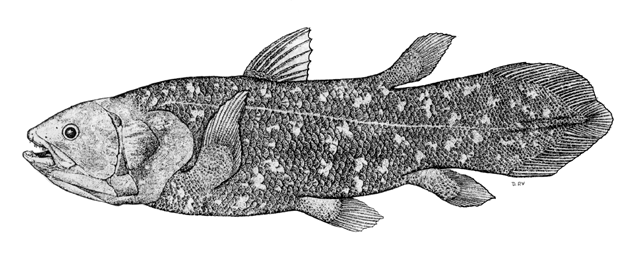| Latimeriidae (Gombessa) |
| 168 cm TL (male/unsexed); 200 cm TL (female); max.weight: 95 kg; max. reported age: 48 years |
|
demersal; marine; depth range 150 - 700 m, non-migratory |
| Indian Ocean: well known population off the islands of Grand Comoro and Anjouan in the Comoros. Other populations in South Africa (Ref. 11228, 38218), Madagascar (Ref. 26162), and Mozambique (Ref. 27415). Likely to occur as strays at islands like Astove and Cosmoledo (Ref. 1623). |
|
Dorsal spines (total): 8-8; Dorsal soft rays (total): 30-31; Anal spines: 0-0; Anal soft rays: 27-31. This species have the following characters: D VIII+30-31; A 27-31; P 29-32; V 29-33; C 20-25/35-38/21-22; LL 94-104; gills 4; gill rakers replaced by spiny tooth-plates. Head naked, the opercular bones exposed; gill cover expanded posteriorly and ventrally as a thick flap of skin; lower jaw with two large, overlapping gular plates; teeth conical, set on bony plates attached to palatines, ectopterygoids, and dentaries; maxilla absent (the structure at the side of the upper jaw that appears to be a maxillary bone is a thick fold of skin connecting the upper jaw to the rear of the lower jaw). Swim bladder elongate, filled with fat; intestine with spiral valve; osmoregulation involves retention of urea and trimethylamine oxide in the blood, but urea is not resorbed by the kidneys and excess salts are excreted by the rectal gland. In adults the brain is incredibly small, occupying only about 1% of the cranial cavity; but in the smallest juveniles, the brain completely fills the cranial cavity. Color in life: dark metallic blue, the head and body covered with irregular white or pale bluish spots. After death, the bluish color fades to dark brownish black. |
| Known as the living fossil. Inhabits steep rocky shores, sheltering in caves during the day (Ref. 38425), with as much as 14 individuals in a single cave (Ref. 38426). Foraging singly over open substrate at night (Ref. 38426), it drifts passively with the current or swims slowly with its paired fins and its second dorsal and anal fins (Ref. 38427). May travel as much as 8 km at night searching for food and retreats to the nearest cave before dawn (Ref. 38426). Preys on fishes and squid (Ref. 26162). Beryx, Polymixia, Symphysanodon, apogonids, a skate, an eel and a swell shark have been known to be eaten (Ref. 11228). Its main enemies are likely to be large sharks (Ref. 26162). Ovoviviparous, with as much as 5-29 young (Ref. 11228, 37171). Gestation period estimated at 3 years, which would be the longest known in vertebrates (Ref. 30865). A small relative gill area (Ref. 38428) restricts coelacanths to a life 'in the slow lane', drift-feeding at night in cold waters and resting in slightly warmer caves for food consumption during day time (Ref. 38429). Recently, Prof Hans Fricke and associates have succeeded in observing and filming Latimeria in their natural habitat. Using a two-man submersible, Fricke found several coelacanths in depths of 120-400 m on the barren lava slopes off Grand Comoro. Coelacanths have distinctive white markings, and this allowed recognition of individuals and tracking of their movements. During the day, Latimeria retreat to caves, with as many as 13 fish crowded together in a single cave. Several individuals occupy overlapping home ranges, and Fricke never saw any aggressive encounters between coelacanths. By resting in caves (were there are no strong currents) the coelacanths save energy and avoid encounters with large predators (deep-water sharks). After sunset, the coelacanths leave their caves and drift slowly across the substrate, presumably looking for food, within 1-3 meters of the bottom. On these nightly hunting forays, the coelacanth may travel as much as 8 km; and before dawn they shelter in the nearest cave. While searching for prey, or moving from one cave to another, Latimeria appears to move in slow motion, either drifting passively with the current and using its flexible pectoral and pelvic fins to adjust its position, or slowly swimming by a synchronous sculling movement of the second dorsal and anal fins. In slow forward swimming, the left pectoral and right pelvic fins move forward, while the right pectoral and left pelvic fins are pulled backward. This tandem movement of alternate paired fins resembles the movement of the forelimbs and hindlimbs of a tetrapod walking on land. Latimeria does not use its lobed fins for walking on the bottom, and even when they are resting in caves they usually do not touch the substrate. Like most slow moving fishes, the coelacanth can make a sudden lunge or fast start by means of a quick flip of its massive caudal fin. During its nightly foraging swims, Latimeria was often seen to perform head-stands, in which it rotates its body into a vertical position, with its head near the bottom and its caudal fin curved perpendicular to its body. It then held this position for two or three minutes at a time. This curious behavior may be used when it is scanning the bottom with its putative electoreceptive rostral organ, or it may be a reaction to the bright lights of Prof. Fricke's submersible (Ref. 38228). |
|
Critically Endangered (CR); Date assessed: 30 June 2000 (A2bcd) Ref. (130435)
|
| harmless |
|
Source and more info: www.fishbase.org. For personal, classroom, and other internal use only. Not for publication.

